Cut-e Tests (2025 Guide)
All products and services featured are independently selected by WikiJob. When you register or purchase through links on this page, we may earn a commission.
Acquired by Aon in 2017, cut-e is a publisher of a range of psychometric and personality assessments.
Since the cut-e Aon acquisition, these assessments are sometimes referred to as Aon tests. However, a cut-e test is still the most popular term owing to its existing position and brand familiarity.
What Are Cut-e Tests?
Tests published by cut-e are designed to help employers identify suitable candidates by measuring their skills, aptitude and personality traits.
They are used in the screening stages of the recruitment process, allowing the hiring team to narrow down its pool of applicants with a series of relevant assessments. They are also often used for career progression, administered as part of internal recruitment.
You may be asked to sit a cut-e test for a range of employment opportunities, including those with many multinational corporations.
Cut-e is the chosen test publisher for big names including Deloitte, Vodafone, Burger King, o2 and EasyJet.
In most cases, cut-e will work with a particular employer to design an online assessment with the most appropriate tests for its recruitment needs. This may be a stand-alone assessment or a combination of the many tests it publishes.
Practice Cut-e Test with JobTestPrep
Cut-e Test Types
A cut-e test typically falls into one of two categories:
-
An aptitude test – Also referred to as a performance or ability test, these measure things like logical thinking, verbal reasoning and numerical skills. Aptitude tests give employers a good indication of how you’ll perform in your future role.
-
A personality test – These assess your behavioral qualities and professional preferences and are predominantly used to determine culture fit.
Cut-e also designs and publishes industry-specific skills tests, which measure particular knowledge and capabilities. As these are both numerous and niche, they are not covered within this article.
The following describes each of the most commonly used cut-e tests in turn, including what it measures and sample questions.

Cut-e Numerical Reasoning Test
Time limit: 12 minutes
Total number of questions: 37
Numerical reasoning tests measure your ability to draw sound conclusions based on statistical information. The cut-e version differs from other test types, in that it is formatted in tabs, each one containing separate data in the form of tables, charts and graphs.
You’ll be presented with a written statement and will need to locate the tab containing the relevant data. Once you’ve found the data, you’ll need to carry out a logical analysis to determine whether the given statement is true or false, or if there is insufficient evidence to state either way.
It’s important to note that all the information you need for a specific question will be contained within a single tab.
Example question:
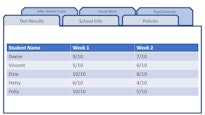
In week 3, Elsie's spelling test results were better than Polly's.
a) True
b) False
c) Cannot Say
Cut-e Verbal Reasoning Test
Time limit: 12 minutes
Total number of questions: 49
In a verbal reasoning test, your critical thinking and language skills are being assessed. Again, in the cut-e test, you’ll be working with various tabs, each containing a passage of text on a particular topic.
You’ll be presented with a written statement and asked to evaluate its accuracy by stating 'true', 'false' or 'cannot say'.
To do so, you’ll need to navigate to a specific tab to find the information you need. Each question will relate to one topic only.
Verbal reasoning tests measure your ability to draw conclusions based solely on the information in front of you. It’s therefore important to be aware of any subconscious bias or pre-existing knowledge that may influence your judgment.
Example question:
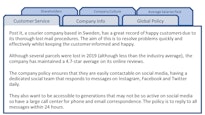
Post It uses three methods to communicate with its customers.
a) True
b) False
c) Cannot Say
Cut-e Mechanical Reasoning Test
Time limit: 15 minutes
Total number of questions: 24
A mechanical reasoning test measures your understanding of physical principles with questions relating to levers, gears, force, pulleys, etc.
In each question on the cut-e test, you’ll be shown a graphic of a mechanical concept and three response statements. You’ll need to determine which response is correct based on the information contained within the graphic.
As these tests assess how well a candidate can apply physical principles, they are used for roles in industry, such as engineering and, of course, mechanics.
Example question:
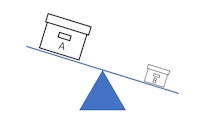
Box A is heavier than Box B.
a) True
b) False
c) Cannot Say
Cut-e Deductive Logic Test
Time limit: 6 minutes
Total number of questions: Unlimited
When it comes to deductive logic, the cut-e test is unique.
Whilst many deductive reasoning tests ask you to draw an evidence-based conclusion from verbal information, cut-e takes a gamified, visual approach.
A grid will appear on-screen, with some boxes blank and others containing shapes. One box will contain a question mark, and it’s your job to decipher which shape belongs in this box.
Each shape can only appear once in each row and each column, so there is only ever one correct answer.
You have six minutes to complete as many problems as possible. As you progress, the test will increase in difficulty, moving from 4x4 to 5x5 grids.
Once you submit your answer, you cannot go back and change it.
Example question:
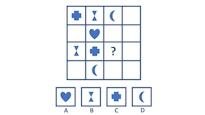
This puzzle needs to be solved so that each row and column has one of each shape.
If you need to prepare for a number of different employment tests and want to outsmart the competition, choose a Premium Membership from JobTestPrep.
You will get access to three PrepPacks of your choice, from a database that covers all the major test providers and employers and tailored profession packs.
Cut-e Inductive Logic Test
Inductive logic is the ability to make assumptions based on what is in front of you.
This skill is most commonly measured through tasks involving relationships between shapes and patterns.
Cut-e has two main inductive logic tests:
Inductive Logic Option 1
Time limit: 12 minutes
Total number of questions: 12
You’ll be presented with a series of 10 tables containing numbers, figures or a combination of both.
Six of the tables are color-coded, indicating they belong to one of two sets. The remaining four tables are to be assigned to either set A or set B.
This is your task. You’ll need to look for rules and relationships in each set to assign the remaining tables to the right one.
Example question:
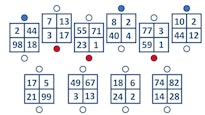
Identify the pattern and color-code the four answer squares appropriately.
The red circles indicate odd numbers and the blue circles indicate even numbers.
Inductive Logic Option 2
Time limit: 5 minutes Total number of questions: 20
In this test, each question revolves around a series of nine images that form a sequence. One of these images will break the rule of this sequence and must be identified as the odd one out.
Example question:
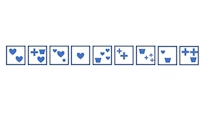
Identify the odd one out.
Cut-e Personality Test
Time limit: N/A
Total number of questions: 100
Known as the ADEPT-15® Workstyles assessment, the cut-e personality test has no time limit, but you must work your way through all 100 questions.
On each page of the assessment, there will be five questions, or rather, five sets of two opposing statements, with a slider in between.
You’ll need to move the slider accordingly in relation to each set of statements to indicate your preference. You can select ‘agree’ or ‘slightly agree’ on either side, but you cannot leave the slider in the middle.
There is no skill being measured here. These tests are designed to establish a culture fit, and your responses will give employers a good idea of whether or not your personality is a good match for the company.
Additional Cut-e Tests
Whilst we’ve covered the tests most commonly used as part of a standard recruitment process, cut-e also publishes several complimentary assessments that may be used in conjunction with those above.
These include:
- Short-term memory test – Candidates have five minutes to complete 10 puzzles, memorizing and identifying a series of pictures.
- Language skills test – A 10-minute assessment in which candidates complete tasks around spelling, definitions and sentence completion, commonly used alongside a verbal reasoning test.
- Situational judgment test – Very much akin to a personality test, applicants are asked to pick their preferred course of action in a series of hypothetical work-based scenarios.
What to Expect When Taking a Cut-e Test in 2025
Regardless of which cut-e test you take, you can expect a very similar experience. All tests are administered online and can be taken anywhere you choose, and on any device, including mobile.
Except for its personality assessment, all cut-e tests are timed and are somewhat shorter than those designed by other test publishers, ranging from five to 15 minutes in duration.
Each cut-e test starts with an introductory video, which will walk you through the questions involved and how to answer them.
There is then an interactive session designed to get you used to using the interface. You’ll need to complete certain tasks to show you understand key actions before you can progress. You’ll then have the opportunity to work through one or two practice questions.
The introductory section and practice questions on a cut-e test are not included in your time limit, so use them wisely and get comfortable with the format before your test begins.
Once your test is launched, you’ll have the allotted time in which to complete as many questions as possible. A progress bar will show how far through the test you are, and you can move from question to question via a navigational menu.
This menu will also show you which questions you have completed, and which remain unanswered, so if you skip one, it’s easy to return at a later time.
You cannot stop or pause a cut-e test once you have started, so be prepared to complete it in one sitting. If you’re required to take more than one assessment, these can be done at separate intervals.
How Is a Cut-e Test Scored?
Scoring methods for cut-e tests can differ depending on the test type in question. Generally speaking though, ability tests – including those covered in this article – are all marked the same way.
You’ll be awarded one point for every correct answer and deducted one point for every incorrect answer.
Personality tests have a more complex scoring method because, technically, there are no right or wrong responses. How you score here will depend on the personality type the hiring company is looking for, and how closely your answers match that profile.
Your cut-e test results will be securely stored and sent to the hiring organization that requested the assessment. You will not receive instant feedback on how well you have performed.
There’s also no guarantee that your potential employer will share your cut-e test results with you. However, they should be readily available on request.
How to Prepare for a Cut-e Test in 2025
Step 1. Practice Specifically for the Cut-e Style
Practice is vital to success in any psychometric test, but since it uses such a unique format, it’s important to use cut-e specific sample tests in your preparation.
Learning to navigate quickly through tabs for numerical and verbal reasoning and understanding the process of cut-e logic tests is half the battle.
Step 2. Use a PC or Laptop
Despite the fact a cut-e test can be taken on a mobile device, it’s recommended that this is a last resort only.
By using a PC or laptop, you’re far less likely to encounter distractions, particularly compared to a phone.
Remember, you have a very strict time limit, so you need full concentration on the task at hand. Also, make sure your browser is up to date and that you’re running off a reliable internet connection.
Step 3. Take It When You’re Most Alert
One of the major benefits of a cut-e test is that it can be taken at any time, provided it is completed before the deadline date.
Use this to your advantage by taking the test when you’re likely to perform at your best.
Some people find it easier to concentrate first thing in the morning, others late at night. Decide what’s right for you and assign this time to your cut-e test.
Step 4. Go Through the Test in Order
The navigational menu of the cut-e interface makes it easy to move from one question to another, whether you’ve completed it or not. However, it’s very much advised that you ignore this functionality, and move through the test as it is formatted.
Flicking back and forth will lead to confusion and eat into your short time frame. Only use the navigational menu to return to unanswered questions if you have spare time to complete them.
Step 5. Balance Speed and Accuracy
Cut-e tests are notoriously short, so it’s important to work quickly. However, this shouldn’t be to the detriment of your accuracy.
It is not a requirement that you complete every single question on your test, so aim for a good balance of speed and precision, answering as many questions as possible, but paying careful attention to the task at hand.
The Cut-e tests have different names to describe their content and the aptitude or proficiency they are assessing.
The Cut-e Scales IX is also known as the 'Discovering Rules' test, and it is an assessment of inductive or abstract reasoning, also known as non-verbal logical thinking.
In this assessment, 20 questions need to be answered in five minutes. Each question is structured to present a series of figures, shapes or images that are connected as a sequence and governed by a particular rule.
To answer the question, the candidate must spot the rule and use it to decide which of the presented figures is the odd one out.
There are several different types of Cut-e tests, all designed to measure different aptitudes, skills, personality traits and work behaviors.
Psychometric tests are designed to look for natural aptitude and predict future success, while skills assessments look at the level of knowledge and learning that a candidate has in a specific area.
Different Cut-e tests include:
- Aptitude - Numerical/verbal/deductive/inductive/mechanical reasoning
- Personality – Personality assessments and situational judgment tests
- Skills – Language, programming, memory
They are short assessments used in both recruitment processes and for training and development in different industries – from aerospace to finance, volume hiring to executive talent searches.
Cut-e tests are delivered online, and the candidate takes them at home in their own time.
The Cut-e tests are a series of assessments that can be used either as a battery or as standalone tests for skills, aptitudes and competency.
Each test has a specific psychometric focus and can be used by the recruitment team to ensure that the candidates put forward for the interview have the inherent talents to be successful. The tests include:
- Verbal Reasoning
- Numerical Reasoning
- Inductive Reasoning
- Deductive Reasoning
- Mechanical Reasoning
- Situational Judgement
- Personality
- Memory
- Language
- SSI
The Cut-e battery of tests is short and simple to administer and can be customized to suit any company in almost any industry. As they are so flexible, several different successful companies use the Cut-e tests as part of their recruitment strategy and to identify potential leaders and find out different training needs for employees already in a role.
These companies include:
- Deloitte
- Siemens
- ISS
- EasyJet
- Virgin Australia
- Credit Suisse
- o2
- Vodafone
The specific tests used by these companies depend on the role that is advertised.
Preparation is the key to success in any testing environment, and the cut-e tests are no different.
You can find free resources, including practice tests, online – and these are useful in several ways.
First, you can use them to identify where you need to revise. It is perfectly normal to have less aptitude in certain areas – like multiplying percentages, for example – and by finding these out through practice tests you can focus your revision.
The second reason that practice tests are so useful is that you will become familiar with the way the assessments are structured and how you need to answer them for the best results. This familiarity will make you feel more comfortable when you need to face the real test.
As you are approaching test day, make sure that you have prepared your exam space – a good, strong connection to the internet and somewhere quiet where you won’t be disturbed. Get the best night’s sleep that you can on the night of the test, and eat a decent, healthy meal beforehand. Stay hydrated, too – all these things will help your brain to work at its full potential.
A good score for a Cut-e test depends on the company that is using them as part of their recruitment process.
The tests are marked according to the correct answers you give – but if you answer incorrectly, then a mark will be taken away.
In the most general terms, you can consider achieving 70% or more as a pass.
When you take the Cut-e tests, your results will be compared against a benchmark to assess whether you have achieved the right score to pass. They will also be compared against the test takers who have applied for the same role – so you need to beat the test, and your competition, to be considered for the role.
The Cut-e series of assessments are designed to be short and simple to administer, so no matter what test you are facing you can be reassured that it will be over before you know it.
Typical aptitude and skills tests last between five and 15 minutes each, so if you are facing several different tests together you might be looking at between 30 minutes and an hour.
The only tests that could potentially last longer are the personality tests – these are untimed (although candidates tend to finish them quite quickly too).
Aon, the company that now owns Cut-e, has a candidate hub which is a great place to practice some of the Cut-e tests online. There is also a wealth of other information in this hub that you might find useful if you know you are going to be taking a Cut-e test.
For more information about the process, what to expect, and the real candidate experience of taking Cut-e tests, including example questions, then articles like this Wikijob one is full of knowledge that you will find useful.
If you want to take free practice tests, then JobTestPrep has some in-depth information about what to expect and a free test. You can also purchase a Prep Pack which is designed to give you the best revision guide, tips, and tricks, and plenty of practice tests and examples so you know what to expect.
When you are looking for the best websites to help you prepare for the Cut-e tests, you should begin by reading all the preparation material on the Aon website, which is the name of the company that now publishes the Cut-e tests. In the candidate hub area are example questions and a lot of resources that should help you.
For more detailed information about what to expect, resources like this Wikijob article can help you – so you know what the structure of each test will be, how many questions and how long it will take. You will also be able to see example questions too.
For full, free practice tests and the opportunity to purchase a Prep Pack full of revision material, tips and tricks, and full-length practice tests with answers, JobTestPrep is the place to go. Designed to ensure that you get the best results, it is a great resource for several different types of tests, including the Cut-e battery.
If you are thinking about how to cheat a Cut-e test, it is not a good idea.
If you are determined, you can get someone else to take the test for you. There are even online places where you can pay someone to log onto the test platform and take the test for you, defrauding the business that you have applied for (and spending money that you did not need to spend).
If you were to get caught cheating, not only would you be out of the running for the role you have applied for, but you are likely to be blacklisted for any role with that company.
Businesses are aware of the risks of cheating, and in some cases, they will make candidates resit the test in one of the later stages of the assessment – and if your scores don’t add up, you will have some explaining to do.
Even if you did cheat and landed your ‘dream’ job, by not matching with the requirements or having the right competencies for the role, you are risking being stuck in a job that you don’t understand, will struggle to learn and don’t enjoy – and even worse, you might be in a workplace culture that does not suit the way you want to work, too.
The best thing you can do to ensure you give reliable performance in the Cut-e test is to revise and complete practice tests, so you can demonstrate that you have what it takes and that you have the right skills and competencies to be successful in the future.
Final Thoughts
If you’re asked to take a cut-e test as part of an online assessment, it is likely because your prospective employer wants to ensure you have the right skills and abilities for the role before inviting you to interview.
Although aptitude tests typically rely on your inherent skills, rather than learned knowledge, it is still important to put in plenty of practice, particularly with a cut-e test as they have such a unique format, and a good performance is crucial if you want to stand shoulders above your competition.




